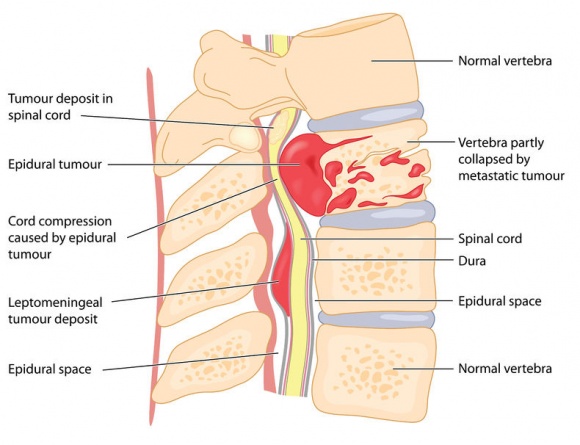
There are various types of treatments available for the spinal tumour. This mostly depends on aspects such as the extent and the location of the disease. Find out more below about spinal tumours and when spinal tumour surgery is considered.
Spinal tumours cover only a small percentage of reason why patients experience back pain and other related symptoms occurring in the spine. The majority of the tumours that originate from the spinal cord include metastases of visceral organ cancers. These are most commonly seen in elder patients. In young patients, usually, tumour-like lesions of the musculoskeletal system and some benign tumours are seen. These often compromise the spinal canal and cause instability.

Spinal tumours are generally studied under two headings.
Primary tumours initiate from the spinal cord itself and its nearby structures. Primary tumours of the spine are rare and most of these lesions are asymptomatic.
Following are some of the types of primary benign tumours of the spine:
Primary malignant tumours of the spine include the following:
These are tumours of distant organs that spread through the lymphatic system and blood circulation to the spine.
There are various types of treatments available for the spinal tumour. This mostly depends on aspects such as the extent and the location of the disease. The most common treatments for spinal tumour removal surgery are detailed below:
Chemotherapy drugs are administered into the vein or orally in the form of a pill. For some specific spinal tumours, these chemotherapy drugs are directly given into the cerebrospinal fluid.
Spinal tumour radiation therapy is a common technique used post-surgical resection of a tumour. This treatment terminates any microscopic tumour cells left behind.
Surgery is performed to destroy a spine tumour that is confined to only one area of the spinal cord. In the case of metastatic spinal tumours, at a minimum, surgery is required just to relieve the symptoms.
Interventional radiology commonly focuses on performing procedures to treat pain and related complications. It may include performing biopsies, and tries to lessen a various symptom that may occur during the tumour treatment.
Targeted therapy is usually combined with other spinal tumour treatments, similar to chemotherapy.
The main advantage of surgery is the possibility of eliminating or significantly reducing the volume of spinal tumours. This can help the patient live a long life.
Sometimes, with the help of a minimum surgery, many symptoms can be relieved.
Following are some of the risks related to surgery for treating spinal tumours:
The doctor will discuss the procedure in detail with the patient and advise them to:
Depending on the location and type of tumour, surgery may include the following steps:
Post-surgery treatment of spine cancer usually includes chemotherapy and/or radiation therapy. Pain-killers are mostly prescribed to control pain.
The outcome of the spinal tumour surgery depends significantly on the overall health and age of the patient. It is also dependent on whether the spinal tumour is malignant or benign, metastatic or primary.
In adults, major complications are reported in up to 14% of the surgeries for various spinal tumour types. Such common complications include systemic infections, surgical site infection, and deep venous thrombosis.
The common primaries to result in spinal metastases are breast, lung, and prostate carcinomas in adults and Ewing sarcoma, leukaemia, rhabdomyosarcoma, and neuroblastoma in children. In patients detected with cancer, spinal metastases is found in 10% and bone metastases in 40% patients.
Following are some of the tissues and areas that may develop cancer and tumours in the spine:
Following are some of the common symptoms:
Spine surgery may be advised to remove a malignant or a benign tumour, relieve its symptoms or reduce its size. When and why spine surgery is performed depends on some of the following factors:
Following are the types of spine surgeries, performed for tumours:
Radiosurgery (CyberKnife), Embolotherapy, and Vertebroplasty or Kyphoplasty are minimally invasive techniques
Spinal stabilisation and decompression may be done using an open approach or as a minimally invasive procedure.
Pain that occurs from spinal tumours is due to instability or nerve compression. This does tend to improve with surgery.